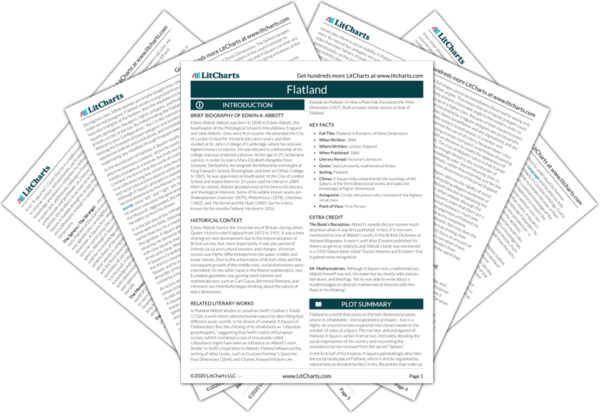Religion, Divinity, and the Unknown
The disconnect between faith, knowledge, and religious orthodoxy is another aspect of Victorian England that Abbott uses Flatland to satirize. Abbott was a devout Christian himself, as well as a prolific writer on Christian theology, and his books occasionally caused a stir in the powerful Anglican Church. Thus, Flatland’s portrayal of a society’s attempt to suppress the “dangerous” knowledge of other dimensions can be seen as an indictment of hierarchical religious institutions (like the Anglican…
read analysis of Religion, Divinity, and the UnknownReason vs. Emotion
In his treatise on Flatland and other worlds, A Square frequently ponders and hashes out the differences between reason and emotion. In Flatland, Reason is seen as superior. It is the exclusive right of the male figures, who believe themselves to be unique in having the ability to think rationally and gain knowledge of their world. Emotion, on the other hand, is limited to the realm of the women and believed to represent the exact…
read analysis of Reason vs. Emotion
Knowledge and Truth vs. Dogma
The second half of Flatland is particularly invested in the search for knowledge and truth. After A Square learns of a higher three-dimensional world, he gains a thirst to discover and understand worlds of four, five, and even six dimensions. Part 1 of the book intricately describes what is taken to be truth in Flatland. However, the exploration of other dimensional worlds in Part 2 immediately exposes how limited that knowledge really is, and, in…
read analysis of Knowledge and Truth vs. DogmaAnalogy as Satire
Throughout Flatland, analogy is used as the primary method for explaining new and unfamiliar concepts by using what’s already familiar to the one being taught. When the Sphere attempts to describe the third dimension, for example, he uses geometrical and arithmetic progression to help A Square make sense of the concept. However, it is soon obvious that analogy, or more specifically, words, fail to fully convey an unfamiliar concept because of the lack…
read analysis of Analogy as Satire







Social Hierarchy and Oppression
Edwin Abbott wrote Flatland as a social satire of Victorian England, and the central target of Abbott’s ire was the class rigidity that characterized English society in the nineteenth century. Because of this, fully half of his book is devoted to an exhaustive cataloguing—to the point of absurdity—of the horrifying and intricate ways in which the social hierarchy of the fictional world of Flatland is established and maintained. Abbott shows that this hierarchy is harmful…
read analysis of Social Hierarchy and Oppression